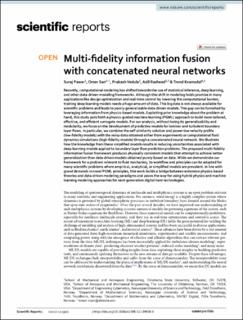| dc.description.abstract | Recently, computational modeling has shifted towards the use of statistical inference, deep learning, and other data-driven modeling frameworks. Although this shift in modeling holds promise in many applications like design optimization and real-time control by lowering the computational burden, training deep learning models needs a huge amount of data. This big data is not always available for scientific problems and leads to poorly generalizable data-driven models. This gap can be furnished by leveraging information from physics-based models. Exploiting prior knowledge about the problem at hand, this study puts forth a physics-guided machine learning (PGML) approach to build more tailored, effective, and efficient surrogate models. For our analysis, without losing its generalizability and modularity, we focus on the development of predictive models for laminar and turbulent boundary layer flows. In particular, we combine the self-similarity solution and power-law velocity profile (low-fidelity models) with the noisy data obtained either from experiments or computational fluid dynamics simulations (high-fidelity models) through a concatenated neural network. We illustrate how the knowledge from these simplified models results in reducing uncertainties associated with deep learning models applied to boundary layer flow prediction problems. The proposed multi-fidelity information fusion framework produces physically consistent models that attempt to achieve better generalization than data-driven models obtained purely based on data. While we demonstrate our framework for a problem relevant to fluid mechanics, its workflow and principles can be adopted for many scientific problems where empirical, analytical, or simplified models are prevalent. In line with grand demands in novel PGML principles, this work builds a bridge between extensive physics-based theories and data-driven modeling paradigms and paves the way for using hybrid physics and machine learning modeling approaches for next-generation digital twin technologies. | en_US |

